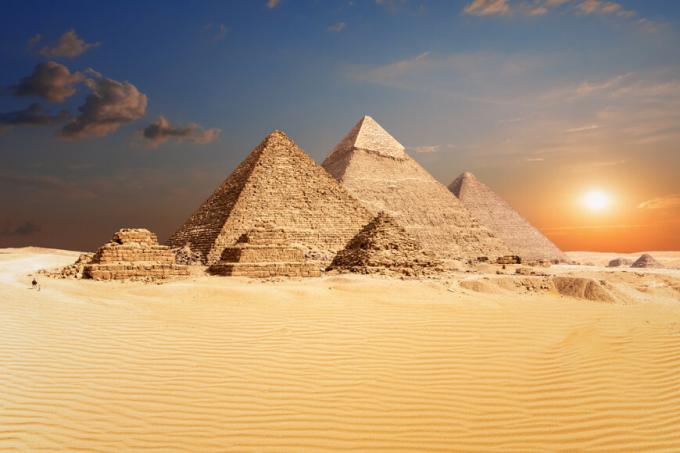A Egyptian art is the art that has been produced throughout the history of Ancient Egypt. The first artistic manifestations of the Egyptians date back to the Pre-Dynastic Period and underwent modifications over the millennia. Egyptian art is influenced by Nubians, Greeks, Romans, among other cultures.
The Egyptians did not understand their art as something to be performed just to fulfill aesthetic satisfaction. They carried it out because it fulfilled a purpose that could be religious, ideological or cosmological. Among the great manifestations of Egyptian art are paintings, death masks, ceramic pieces and, of course, the pyramids.
Read too: What was religion like in Ancient Egypt?
Summary about Egyptian art
The Egyptians always performed their art with the intention that it fulfill a religious, ideological or cosmological purpose.
Among Egyptian artistic manifestations are tomb paintings, small sculptures, statues, temples, pyramids, etc.
Egyptian art was influenced by various ancient peoples, such as the Greeks and Romans.
Egyptian art sought to be symmetrical, as a way of sustaining the harmony of the Universe.
The pyramids are great creations of Egyptian art.
What was art to the Egyptians?
For the Egyptians, art was created only for purposes and features relevant to their worldview. This notion differs from the current notion of art, as we currently understand that art is the practice through which humanity expresses itself aesthetically and communicatively, using it as an escape to express feelings, with freedom to the creative ability to create something considered beautiful — therefore, naturally, art can be used as a way for a person to obtain their sustenance.
In turn, the Egyptians had a specific sense of aesthetics to consider what art was considered beautiful, and this sense could be used to guide them in their artistic expressions. However, Egyptian art no was guided the idea of “art for art’s sake”, that is, by the artist's desire to produce something aiming solely for his own satisfaction.
Egyptian art was created according to a purpose, and all artistic manifestations — whether written texts, paintings, sculptures, temples, among others — fulfilled a function. Thus, this art was guided by its functionality, especially functionality religious, ideological and cosmological. In this way, Egyptian art was produced only when commissioned.
This art reproduced the values of the elite, as it was the class that requested the creation of artistic works in Egypt, which were produced thinking about a very important concept for Egyptian cosmology. This concept is ma’at, which reflects an idea of maintaining the harmony of the Universe. Art did not escape this and was produced in a way to preserve this harmony.
Main highlights of Egyptian art

Egyptian history began in the Pre-Dynastic Period, which dates back to 6000 BC. C., and extended until 3150 a. W. Thus, the first artistic expressions of Ancient Egypt cover this period. This art manifested itself through paintings on rocks or paintings on ceramic pieces. From then on, Egyptian art underwent numerous transformations, being influenced by different ancient peoples.

During the Old Kingdom (2613 a. W. - 2181 a. C.), historians identified a kind of standardization in Egyptian art, produced to meet the aesthetic ideals of the capital, Memphis. Historians have identified many similarities in the artwork of the period, but the biggest highlights of this period are the Egyptian pyramids. It was during this period that the pyramids of Giza were built.

During the Middle Kingdom (2040 a. C - 1782 a. C.), historians and experts in Egyptian art understand that there was a change in the style of the works created, becoming more creative. Furthermore, Egyptian art began to represent elements from the lower classes of society, which had not happened until then. It is also a period of great architectural works, such as temples and statues, for example.

From the New Empire (1570-1069 a. C.), the biggest highlight is the Tutankhamun's death mask, Egyptian pharaoh who died under mysterious circumstances at around 18 years of age. His reign was not significant, but the quality of the items and the preservation of his tomb, found in 1922, gave this pharaoh popularity. The bust of Nefertiti is also an important work from this period.

Throughout these and many other periods of Egyptian history, the art ofAncient Egypt suffered strong influences of different people neighbors and people who temporarily conquered Egyptian territories. Egyptian art was influenced by people such as the Hyksos, Nubians, Greeks, Romans, among others.
See too: Baroque art — the art of one of the artistic movements of the Modern Age
Egyptian pyramids
Egyptian architecture is one of the great highlights when it comes to art. These people were marked by great constructions, such as sumptuous temples, magnificent statues, obelisks and, of course, the grandeur of the pyramids. The architectural knowledge of the Egyptians changed as these people acquired knowledge.
The first Egyptian buildings were made of clay bricks. Over the millennia, the Egyptians became capable of building gigantic pyramids, with stone blocks that weigh tons. The pyramids were tombs built to house thes bodys of pharaohs who passed away, but the first Egyptian tombs were built during the Predynastic Period and were called mastabas.
The most famous pyramids in Egypt are the pyramids of Giza, a set of three pyramids built for the pharaohs Cheops, Chephren and Menquerinos. The three are located on the outskirts of the city of Cairo, capital of Egypt. Of these three, the largest is the Great Pyramid of Giza, the pyramid of Cheops, which is 142 meters high.

Historians are still unsure how the Egyptians were able to build pyramids of this size. Anyway, The Great Pyramid of Giza was considered one of the seven wonders of the ancient world, the only one still in existence. It is considered a cultural heritage of humanity.
Image credit
[1] Irina Kononova / Shutterstock



